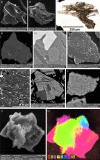Phases in fine volcanic ash
- PMID: 37735194
- PMCID: PMC10514198
- DOI: 10.1038/s41598-023-41412-x
Phases in fine volcanic ash
Abstract
Volcanic ash emissions impact atmospheric processes, depositional ecosystems, human health, and global climate. These effects are sensitive to the size and composition of the ash; however, datasets describing the constituent phases over size ranges relevant for atmospheric transport and widely distributed impacts are practically nonexistent. Here, we present results of X-ray diffraction measurements on size-separated fractions of 40 ash samples from VEI 2-6 eruptions. We characterize changes in phase fractions with grainsize, tectonic setting, and whole-rock SiO2. For grainsizes < 45 μm, average fractions of crystalline silica and surface salts increased while glass and iron oxides decreased with respect to the bulk sample. Samples from arc and intraplate settings are distinguished by feldspar and clinopyroxene fractions (determined by different crystallization sequences) which, together with glass, comprise 80-100% of most samples. We provide a dataset to approximate glass-free proportions of major crystalline phases; however, glass fractions are highly variable. To tackle this, we describe regressions between glass and major crystal phase fractions that help constrain the major phase proportions in volcanic ash with limited a priori information. Using our dataset, we find that pore-free ash density is well-estimated as a function of the clinopyroxene + Fe-oxide fraction, with median values of 2.67 ± 0.01 and 2.85 ± 0.03 g/cm3 for intraplate and arc samples, respectively. Finally, we discuss effects including atmospheric transport and alteration on modal composition and contextualize our proximal airfall ash samples with volcanic ash cloud properties. Our study helps constrain the atmospheric and environmental budget of the phases in fine volcanic ash and their effect on ash density, integral to refine our understanding of the impact of explosive volcanism on the Earth system from single eruptions to global modeling.
© 2023. Springer Nature Limited.
Conflict of interest statement
The authors declare no competing interests.
Figures









References
-
- Dingwell DB, Lavallée Y, Kueppers U. Volcanic ash: A primary agent in the Earth system. Phys. Chem. Earth. 2012;45–46:2–4.
-
- Ayris PM, Delmelle P. The immediate environmental effects of tephra emission. Bull. Volcanol. 2012;74:1905–1936.
-
- Mather TA. Volcanoes and the environment: Lessons for understanding Earth’s past and future from studies of present-day volcanic emissions. J. Volcanol. Geoth. Res. 2015;304:160–179.
-
- IAEA. Volcanic hazard assessments for nuclear installations: Methods and examples in site evaluation. IAEA Tecdoc Ser.1795, 283 (2016).
-
- Brown SK, et al. Global Volcanic Hazards and Risk. Cambridge University Press; 2015. Global volcanic hazard and risk; pp. 81–172.
Grants and funding
LinkOut - more resources
Full Text Sources
Research Materials
Miscellaneous

